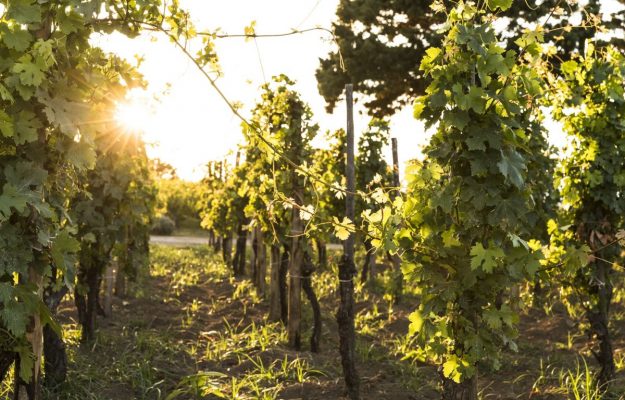Climate Change has been a topic of discussion in wine-growing environments for decades, and it essentially concerns the generalized increase in environmental temperature, with very long periods of drought (even before veraison) and a decrease in the organic matter content of the soil (during grape ripening). The latter is caused both by extreme weather events and, in some cases, a lack of human attention, as well as an increase in CO2 content in the atmosphere. Although the issue has been addressed for some time, we have only recently become fully aware of the dramatic problems caused by climate change in the viticultural and oenological fields.
In terms of winemaking and wine quality, the related studies and oenological literature produced thus far are still marginal and require more and more precise scientific insights. There is still much work to be done, and there is also plenty of room for research aimed at mitigating the effects of climate change, rising temperatures, and drought on grape composition and wine quality. To make an interesting excursus on the effects of climate change in the vineyard and in the cellar, from a purely technical point of view, is the oenologist and biologist Dora Marchi, technical director, and head of the quality control laboratory of the Center for Applied Research in Oenology “Enosis Meraviglia”, by the oenologist Donato Lanati.
“According to Dora Marchi, the increase in environmental temperature and the resulting extreme weather events are largely attributed to an increase in greenhouse gas content (CO2 and CH4) in the atmosphere. For this reason, numerous studies have been carried out in various viticultural environments to determine the influence of these factors on the metabolism of the vine, including: the production of primary and secondary metabolites in grapes, influence on vine metabolism, and influence on production. The results, however, are still partial, in part, contradictory and suggest specific insights into the context of the individual/different environments”.
Indeed, climate change has both positive and negative effects in different environments. Furthermore, the influence of individual variables is only visible in a few cases; in most cases, the variables are interdependent, and the outcomes vary depending on the different interactions. “One of the results shared by all published research is the advance of flowering and, consequently, grape ripening, indicating a clear temporal detachment from what happened in the middle of the last century and/or in times even further back. This implies that the spring climate has a significant, if not decisive, impact on veraison, ripening, and, as a result, the composition of the grape itself”.
Among the most pressing issues, which also affect environments traditionally suited to the production of great wines, is the significant increase in grape sugar content at harvest. “This phenomenon is generally accompanied by a decrease in malic acid but not always by a decrease in titratable acidity and an increase in the pH of the must extractable from the grape”. Another critical factor to consider is the soil’s water condition. The combination of long periods of high temperatures and soil water shortages causes the most damage to grape composition.
When thermal and water stress occurs in conditions of strong light - continues Dora Marchi - as a defense mechanism against UV-A rays, the cells of the skins synthesize flavanols, the content of which can generate instability in the wine (precipitates of quercetin). Wines lacking in anthocyanins, which prevent quercetin precipitation via the formation of soluble molecular associations (anthocyanins-quercetin) known as co-pigmentation complexes, pay the price. The most dramatic effect, however, is that under the extreme conditions described above, the grapes achieve good cellular maturity (commonly known as phenolic maturity), with high sugar content, low titratable acidity, and a high pH”.
Long periods of high temperatures are also associated with low anthocyanin content in dark-berry grapes. “A phenomenon that may or may not be caused by the inhibition of the synthesis and/or degradation of these compounds. In fact, high temperatures inhibit the expression of some genes in the flavonoid biosynthetic pathway, leading to even more dramatic consequences when the event lasts for a long time so that the degradation reactions of single classes of flavonoids can exceed those of synthesis”.
Extreme thermal events have less of an impact on the synthesis of skin flavanols (catechins and oligomeric and polymeric proanthocyanidins) than anthocyanins because it occurs before veraison when the soil still has water reserves in certain environments, and when the temperatures are higher. “There is sometimes a poor extractability of polymer flavanols (tannins) in thermally stressed grapes, and the wines can be deficient in both anthocyanins and tannins”, recalls the winemaker.
The vinification of dark berry grapes is also complicated because their total acidity is particularly low, pH is particularly high, and tannins are sometimes ripe and not very astringent, and other times astringent, dry, and green. “A problem that official enology has yet to address and that necessitates the development of new winemaking and aging techniques. White grapes face similar issues. In this case, when the titratable acidity is still high, the pH is low, and the malic acid is still present in significant quantities, early grape harvesting is required to avoid heavy interventions at the must and wine levels”.
However, anticipating the harvest increases the risk of encountering a lack of varietal aromas and bitter flavors in the wine. In fact, even a few days before harvest, there is a significant decrease in titratable acidity, a significant increase in pH, and an almost complete loss of malic acid, with no corresponding improvement in sugar content or varietal aromas. In recent decades, excessively long and recurring periods of particularly high ambient temperatures have resulted in a significant decrease in the varietal aroma content of the terpineol, particularly in aromatic grapes such as Moscato Bianco. In any case, aside from varietal aromas, the fundamental issue is titratable acidity, a low malic acid content, and an excessively high pH.
Furthermore, the phenomenon of pinking is particularly common in the vinification of whites in areas most affected by climate change. In these cases, the wine turns pink, which no amount of bisulfite ions can remove because the pigments responsible for pinking do not interact with the same ions. Only through specific tests can this phenomenon now be predicted and thus limited. Despite all this, it is possible to produce high-quality white wines even in areas prone to extreme temperatures: by using appropriate acidification, vinification, and aging techniques, the quality of these wines can be good, and sometimes even better.
Copyright © 2000/2026
Contatti: info@winenews.it
Seguici anche su Twitter: @WineNewsIt
Seguici anche su Facebook: @winenewsit
Questo articolo è tratto dall'archivio di WineNews - Tutti i diritti riservati - Copyright © 2000/2026









































































































































































































